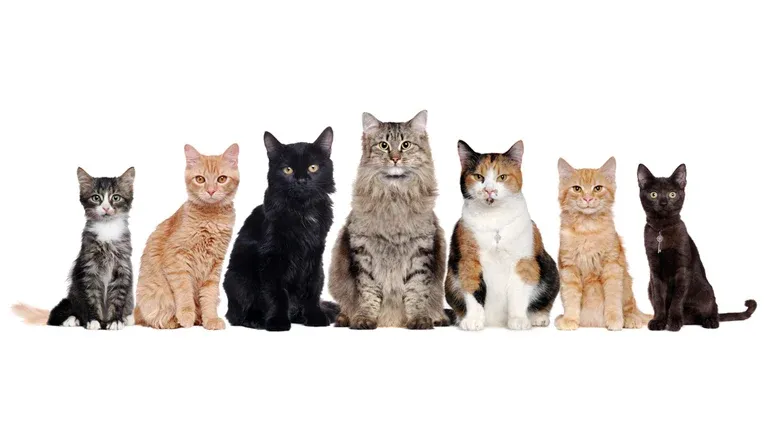What Your Cat's Coat Color Can Tell You About Her Behavior
Is there any truth to the connection between coat colors and aggressiveness and bossiness in felines? This study of 1,274 cats reveals some interesting findings, including the colors associated with the most and least aggressive behaviors. Plus — how to live in harmony with a kitty control freak.

STORY AT-A-GLANCE
- A study of over 1,200 domestic cats suggests calico and tortoiseshell coat colors are associated with more aggressiveness toward humans
- For the study, aggressiveness was defined as hissing, chasing, biting, swatting or scratching during interactions with humans
- The study also suggests gray-and-white and black-and-white cats are only slightly less aggressive than calicoes and torties, and researchers observed that orange female cats, including torties and calicoes, are aggressive with much higher frequency than other cats
- The researchers emphasize that they are not suggesting anyone avoid having these cats in their homes, because most of them make wonderful pets
- If you have an aggressive cat in the family, it’s important to learn the signs of impending aggression, as well as how to avoid situations in which kitty may become aggressive with you
Editor's Note: This article is a reprint. It was originally published July 5, 2016.
Well now here's a study that's surely firing up cat lovers the world over! Researchers at the University of California, Davis have surmised that calicoes and tortoiseshells ("torties") tend to give more cattitude than kitties with other coat patterns.
Dr. Elizabeth Stelow, a behavioral expert in the UC Davis William R. Pritchard Veterinary Medical Teaching Hospital and lead study author told The Seattle Times the results of the research confirm "long-standing observations among veterinarians that such cats are often 'difficult.'"1
The study found that calicoes and torties are more likely that other cats to "hiss, chase, bite, swat or scratch" while interacting with humans. Titled "The Relationship Between Coat Color and Aggressive Behaviors in the Domestic Cat," the study was published in the Journal of Applied Animal Welfare Science.2
Needless to say, there has been no shortage of comments from cat guardians wherever mention of the study appears online! For those of you who aren't familiar with cat coat colors, calicoes are primarily white with patches of orange and black:

Tortoiseshells have coats that feature random arrangements of black, brown, amber and red patches:

These kitties possess two X chromosomes that create their coloring, which means the vast majority of both calicoes and torties are female.
Coat Colors of Other Feisty Felines
The UC Davis researchers set out to explore the relationship between coat color patterns in domestic cats and aggression toward humans in general; aggression while being petted, groomed, or disciplined; and aggression during veterinary visits.
The study involved 1,274 cats, including 617 females and 657 males with ages ranging from 18 to 60+ months, and 13 coat color categories. The owners of the cats were recruited from a UC Davis Facebook page, as well as postings to general cat-lover internet sites.
The research data was collected from an online survey the cats' guardians completed. The survey gave no indication of the focus of the study, but only asked participating cat owners questions about their pet's behaviors, coat color category, and a written description that best fit their cat.
Along with the calicoes and torties, the researchers discovered that kitties with gray-and-white coats and black-and-white coats were also fairly fiery, whereas cats with solid coats were far less likely to be aggressive.
Analysis of the answers to the survey found "statistically significant differences between the frequency of such behaviors in 'orange females' — including torties and calicoes."
Stelow and her team believe their study results may suggest the same genes responsible for coat color also play a role in aggression, but more research is needed to test their theory.
These Results Should NOT Discourage You to Adopt Cats with Calico or Tortoiseshell Coats
The UC Davis researchers don't want their study results to discourage people from adopting a tortoiseshell or calico cat. Most guardians of these feisty felines rave about their high-energy, spirited kitties.
It's also important to understand that aggression in cats is very different from canine aggression. "Dogs show a very, very wide range from not aggressive at all to capable of killing," says Stelow.
"The overwhelming majority of cats are not the least aggressive," she continues, and kitties who do have those tendencies usually display them in very subtle ways.
"We are not suggesting that anyone avoid having these cats in their homes," Stelow said of calicoes and torties. "Most of them make lovely pets. It's just information to help you understand what you might be up against."3
The major limitation of the study was that the researchers didn't personally observe the cats, but instead relied on the input of the cats' owners, which naturally involves their subjective opinion of their cat's behavior.
Other issues included small sample sizes for certain coat colors, and the influence of environment and neuter status on behavior. But with that said, the study is the first of its kind to look at the relationship between coat colors and behavior in kitties.
"We thought the findings were very interesting, and we would love other researchers to take the baton and run with it, to look at the genetics of why this may be happening," Stelow said.
Is Your Cat the Boss of You?
According to Dr. Nicholas Dodman, director of the animal behavior program at the Tufts University Cummings School of Veterinary Medicine, cats organize socially in a "despotic hierarchy" where one cat calls the shots for the others, who assume roles as subordinates.4
Another social structure adopted by housecats involves less rigidity and more sharing. For example, if the highest level of the cat tree is the favorite of all the cats in the household, the bossier cat gets to use it first and then will relinquish it later in the day to another cat.
Both these social arrangements seem to point to the existence of higher status cats in multi-cat environments. If this is the case, it's conceivable the owner of a "boss cat" could be — in the eyes of the cat — just another employee in his organization.
Aggression in Bossy Cats Isn't Fear-Based
Petting-induced aggression may be instrumental in nature, meaning it is a means to an end. When a kitty gets aggressive while being petted, the usual response of his human is to stop petting or touching him, which is what the cat hoped to accomplish with his aggressive behavior. He used aggression to get a desired result.
Cats who display petting-related aggression also tend to get hostile around food, don't appreciate being disturbed while resting, will not tolerate being stared at, don't care to be picked up or held, and show hostility when reprimanded.
In a nutshell, these bossy felines have control issues. They bite their owners on a specific body part (the nose and toes are particular favorites) to get them moving in the morning, when their meal doesn't arrive fast enough or isn't to their liking, or when trying to get their human to interact with them.
Experts believe this behavior isn't related to fear, as it often is in dogs. To the contrary, these cats seem quite confident and bossy by nature. Interestingly, most overassertive cats belong to agreeable, affectionate owners, so conflict isn't a motive for kitty's behavior. Some cats are pushy, but stop short of aggression. Bossy cats often stop at nothing to get what they want.
How to Live in Harmony with a Kitty Control Freak
Depending on the severity of the problem, you can try tackling it yourself, or you can consult a certified animal behavior specialist who has experience with feline aggression.
It's important to learn the signs of impending aggression in cats. These include narrowed eyes, furtive glances at the obstacle or irritant (your hand, for example), ears swiveled sideways and flattened against the head, and/or a twitching tail. You must also learn to avoid incidents in which your cat may become aggressive with you:
- If you happen to be holding your cat when any of the above signs appear, stop what you're doing, stand up if you're seated, and let the cat drop gently to the ground. If you're standing, bend forward from the waist and release kitty either to the floor or onto a piece of furniture.
Increasing your grip on a cat about to show aggression — even when your only intent is to lower her from your lap or arms to the floor — can exacerbate the situation. - If your cat is aggressive at feeding time, you'll need to prepare her meals while she's out of the room. Place her food bowl in its usual spot and then let her into the area to eat.
- If your cat bites you to wake you up in the morning, consider keeping him out of the bedroom at night.
- Cats who aggressively respond when picked up should not be picked up, except when absolutely necessary.
- Physical punishment is a bad choice with any cat, and with aggressive felines it serves only to increase aggression.
The next phase is to train your pet to obey commands to receive things she values, like food. With the proper incentive (food), cats can be clicker-trained fairly easily to perform certain behaviors like sit.
There are Bach flower, homeopathic and herbal remedies available that can help reduce inappropriate emotional responses in kitties. Consult with your holistic or integrative veterinarian about supplements that might benefit your cat, including L-theanine, chamomile, and passionflower.
Conventional veterinarians often automatically prescribe medications that act on serotonin levels, but as always, only give drugs for worst-case scenarios, when all other attempts to modify a pet's behavior have proved ineffective, or for very short periods in conjunction with behavior modification.
Using behavior modification plus natural emotional support remedies allows you and your fractious feline to live more harmoniously together, without the use of drugs.











